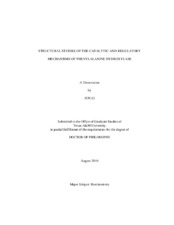| dc.description.abstract | The catalytic and regulatory mechanisms of phenylalanine hydroxylase were
investigated by structural studies of in this research. Phenylalanine hydroxylase (PheH)
hydroxylates phenylalanine to produce tyrosine using tetrahydrobiopterin (BH4) and
oxygen. The three ligands to the iron, His285, His290, and Glu330, were mutated to
glutamine, glutamate, and histidine. All the mutants had low but measurable activity.
Mutation of Glu330 had the greatest effect on activity and mutation of His290 the least.
All the mutations resulted in an excess of tetrahydropterin oxidized relative to tyrosine
formation, with mutation of His285 having the greatest effect on the coupling of the two
partial reactions. All the mutants greatly decreased the affinity for iron, with mutation of
Glu330 the most deleterious. The results complement previous results with tyrosine
hydroxylase in establishing the plasticity of the individual iron ligands in this enzyme
family.
Hydrogen/deuterium exchange and mass spectrometry showed that peptides lying
in the interface between the regulatory and catalytic domains display large increases of
deuterium incorporation in the presence of phenylalanine. However, the effects of phenylalanine on a mutant enzyme lacking the regulatory domain are limited to peptides
surrounding the binding site of phenylalanine. These results support the autoinhibitory
function of the N-terminus of PheH. No peptides show a changed deuterium
incorporation pattern in the presence of BH4, suggesting that BH4 binding does not
change the structure significantly from the resting form. In phosphorylated PheH, three
peptides show a deuterium incorporation pattern similar to that of unphosphorylated
PheH plus phenylalanine, while the other peptides sensitive to phenylalanine binding in
unphosphorylated PheH show the same pattern as that of unphosphorylated PheH
without phenylalanine. Therefore, the conformational changes induced by
phosphorylation are similar to but not identical to those associated with phenylalanine
activation.
The isolated regulatory domain (PheH1-117) was expressed and purified using a QSepharose
column followed by a gel filtration column. Analytical gel filtration shows
that PheH1-117 exists as a dimer in solution. In the presence of phenylalanine, the
retention time of PheH1-117 is significantly changed. The 1H-15N NMR spectra of PheH1-
117 show that the cross-peaks of several residues are altered in the presence of
phenylalanine. These results support the existence of a regulatory binding site for
phenylalanine in the regulatory domain of PheH. | en |


